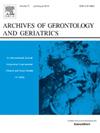Application of wearable sensors in constructing a fall risk prediction model for community-dwelling older adults: A scoping review
IF 3.5
3区 医学
Q2 GERIATRICS & GERONTOLOGY
引用次数: 0
Abstract
Background
Falls are a particularly important public health problem among older people. Early identification of risk factors is crucial for reducing the risk of falls in older adults. Studies have confirmed the effectiveness of sensor-based fall risk prediction models for the older population. This article aims to sort out the current use of wearable sensors in building fall risk models for older adults in the community and explore the suitable use of sensors in model construction and the prospects and possible difficulties of model application.
Methods
This scoping review was conducted from 26 November 2023 to 9 March 2024. It was searched through Web of Science, PubMed, OVID, EBSCO and CNKI using the terms “wearable sensor” or “inertial sensor” or “inertial motion capture” or “wearable electronic devices” or “IMU” or “MEMS” or “accelerometer” or “gyroscope” or “magnetometer” or “smartphone” and “fall” and “predict” or “prediction” and “older adults” or “older men” or “older women” or “elderly” and “community” or “neighborhood” or “dwelling”.
Results
Thirty-one articles were included, and the selection of sensor type, location, and other characteristics and indicators, as well as model types, was summarized.
Discussion and Conclusions
Wearable sensors with a frequency of 100 Hz located in a combination of spine/ pelvis/ hip-shank-feet position is recommended. In addition, walking tests and TUG and its variants are appropriate in the community. However, more empirical research is needed to obtain the best model construction combination and apply it effectively to the community.
应用可穿戴传感器构建社区老年人跌倒风险预测模型:范围综述。
背景:跌倒是老年人中一个特别重要的公共健康问题。早期识别风险因素对于降低老年人跌倒风险至关重要。研究证实了基于传感器的老年人跌倒风险预测模型的有效性。本文旨在梳理目前可穿戴传感器在构建社区老年人跌倒风险模型中的使用情况,探讨传感器在模型构建中的适用性以及模型应用的前景和可能存在的困难:本次范围界定综述于 2023 年 11 月 26 日至 2024 年 3 月 9 日进行。使用 "可穿戴传感器 "或 "惯性传感器 "或 "惯性运动捕捉 "或 "可穿戴电子设备 "或 "IMU "或 "MEMS "或 "加速度计 "或 "陀螺仪 "或 "磁力计 "或 "智能手机 "和 "跌倒 "和 "预测 "或 "预测 "和 "老年人 "或 "老年男性 "或 "老年女性 "或 "老年人 "和 "社区 "或 "邻里 "或 "住所 "等术语,在 Web of Science、PubMed、OVID、EBSCO 和 CNKI 上进行了检索。结果:收录了 31 篇文章,并对传感器类型、位置和其他特征与指标以及模型类型的选择进行了总结:建议使用频率为 100 Hz 的可穿戴式传感器,传感器应位于脊柱/骨盆/臀部-手脚的组合位置。此外,步行测试和 TUG 及其变体也适合在社区使用。不过,还需要进行更多的实证研究,以获得最佳的模型构建组合,并将其有效地应用于社区。
本文章由计算机程序翻译,如有差异,请以英文原文为准。
求助全文
约1分钟内获得全文
求助全文
来源期刊
CiteScore
7.30
自引率
5.00%
发文量
198
审稿时长
16 days
期刊介绍:
Archives of Gerontology and Geriatrics provides a medium for the publication of papers from the fields of experimental gerontology and clinical and social geriatrics. The principal aim of the journal is to facilitate the exchange of information between specialists in these three fields of gerontological research. Experimental papers dealing with the basic mechanisms of aging at molecular, cellular, tissue or organ levels will be published.
Clinical papers will be accepted if they provide sufficiently new information or are of fundamental importance for the knowledge of human aging. Purely descriptive clinical papers will be accepted only if the results permit further interpretation. Papers dealing with anti-aging pharmacological preparations in humans are welcome. Papers on the social aspects of geriatrics will be accepted if they are of general interest regarding the epidemiology of aging and the efficiency and working methods of the social organizations for the health care of the elderly.

 求助内容:
求助内容: 应助结果提醒方式:
应助结果提醒方式:


